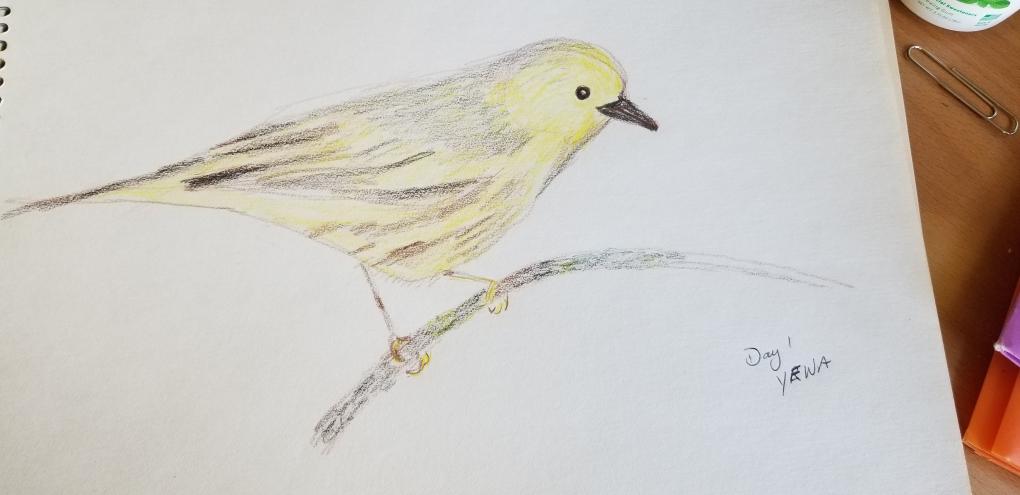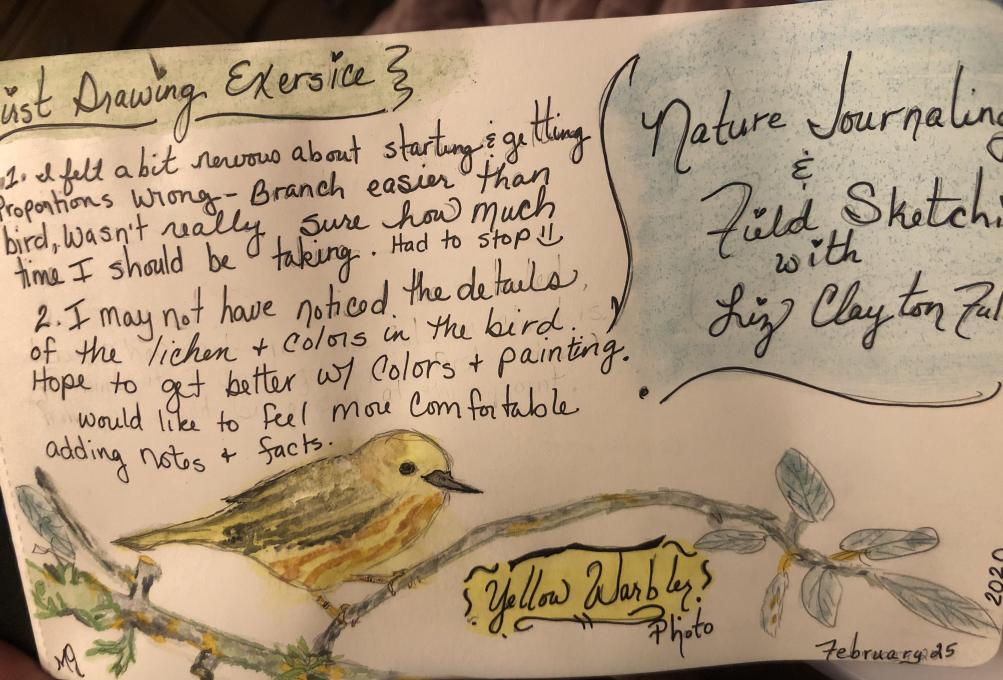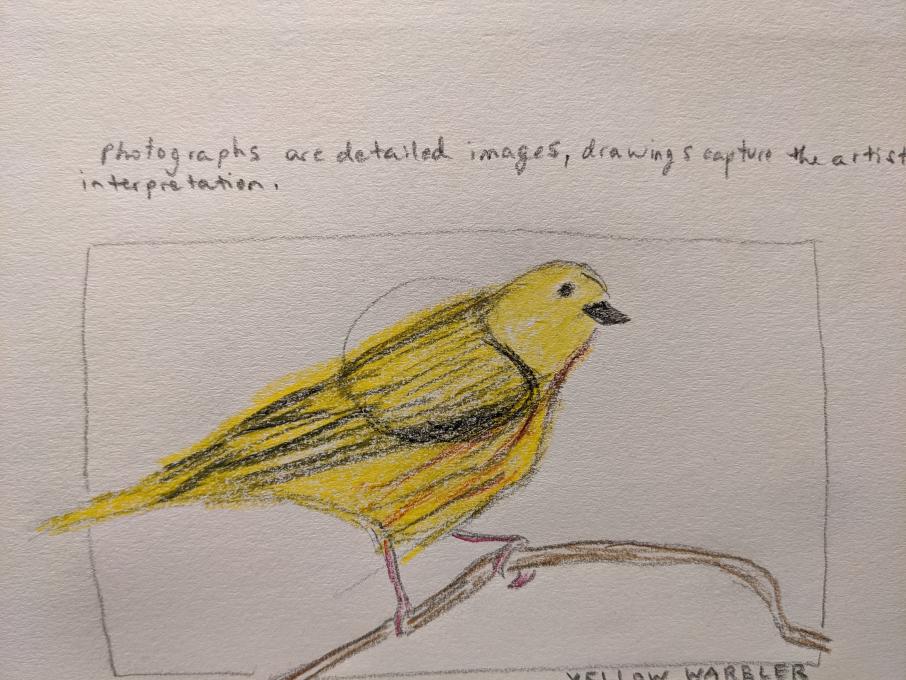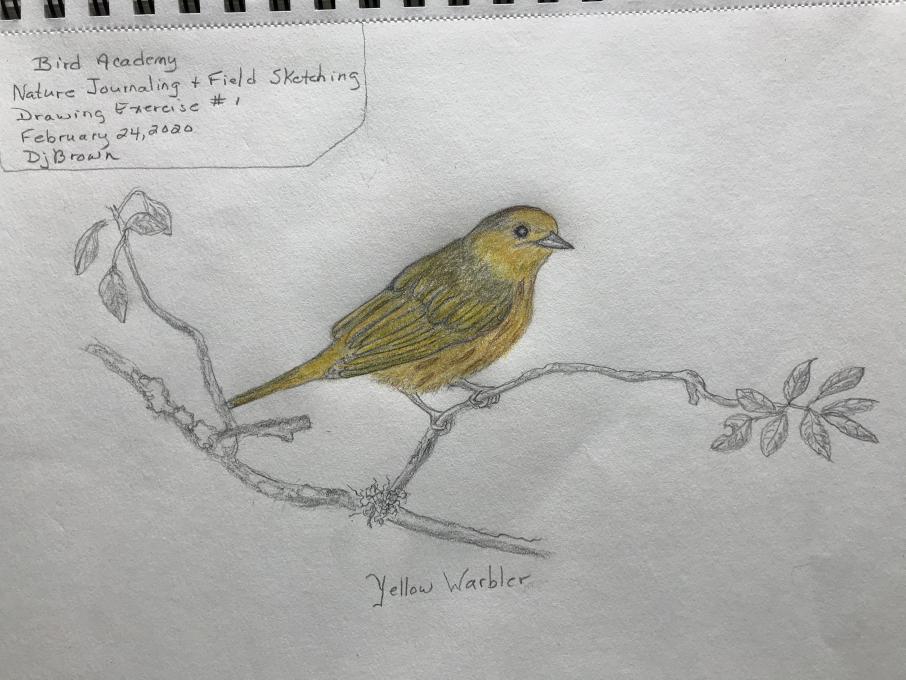The Cornell Lab Bird Academy › Discussion Groups › Nature Journaling and Field Sketching › Jump Right in!
-
I found the whole exercise challenging, particularly trying to get things to scale, and shading correctly. I also would not have noticed all the detail in the leaves, like the blemishes and where an insect had apparently eaten a pice.

-

-
I agree, the branch and leaves were hard and how the heck does one draw moss?
-
-

-
- I was excited to try drawing right away. I knew it would be rough, and could only get better.
- I was slightly impatient, and my wrist started to hurt. Drawing feathers and textures and shadows is a challenge for me.
- I think I wouldn't have noticed the little talons, and how they did not all curl around the branch.
- I'm not sure what the last question is asking...

-
 It helped me to look at details that I would not see by looking though a photo. It was difficult to draw feathers. I felt that more I tried to put details, further the drawing gets from the actual look. I am looking forward to learning painting different shades of colors.
It helped me to look at details that I would not see by looking though a photo. It was difficult to draw feathers. I felt that more I tried to put details, further the drawing gets from the actual look. I am looking forward to learning painting different shades of colors. -
 I really enjoyed drawing the leaves and branch but struggled with the bird. I couldn't get the depth in the feathers that I could see in the photo so I tried adding some outlines but I'm still not happy with how it turned out.
I'm excited to continue with the course to see how I can improve. I'm leaving the page blank next to this drawing so I can come back a re draw it right next to this one to directly compare the two.
I really enjoyed drawing the leaves and branch but struggled with the bird. I couldn't get the depth in the feathers that I could see in the photo so I tried adding some outlines but I'm still not happy with how it turned out.
I'm excited to continue with the course to see how I can improve. I'm leaving the page blank next to this drawing so I can come back a re draw it right next to this one to directly compare the two. -
That's a great idea about the blank page, Keisha. I love the colors in your drawing, and the branch makes me happy. :-)
-
-
1. Its good to draw from a photo I can take my time and and se more details the more Im coming in to the state of the right side of the brain. Nothing was easy its the first time I draw in 20 years, but an interesting thing is that I normaly write with my left hand but its easier to draw with the right hand isnt that interesting ? 2. I noticed more of the small details in the wings, the claws, and the colours ! It is a difference to notice more details and study the details !
-
I enjoy drawing from a photo. I can see the details and do not feel rushed. I can look and study the shapes. This may change as I get more proficient at drawing. I plan on using photos and drawing from them. I will use my observations to catch behavior and my thoughts in the journal and try putting the 2 together.
-

-
Added some more to my first journal page, can't wait for spring to get outside!

-
-
Embarrassed at home bad it is
-
After uploading the image yesterday, I decided to add some descriptive information. Drawing from a photo is one thing, but I don't see how I'm going to do it from a moving object!
-

-

-
What are chirps? How do I get or give them? oh never mind. I figured that chirps are just comments.
-
 I just used my mechanical pencil then filled in with my kid's colored pencils. Didn't want to touch those watercolors yet, since I'm sure I would have made a mess. What I find impossible is how to make the "outline" disappear. Also, my drawing looks flat. I need to learn how to shade or whatever you call it to give the subject depth and curves and volume.
I just used my mechanical pencil then filled in with my kid's colored pencils. Didn't want to touch those watercolors yet, since I'm sure I would have made a mess. What I find impossible is how to make the "outline" disappear. Also, my drawing looks flat. I need to learn how to shade or whatever you call it to give the subject depth and curves and volume. -
I like it! I am too scared to touch the watercolors yet, too. :-)
-
-
I tried to upload some pictures but I failed. It's ok. I am going to type here. So I tried to draw the bird with my pen first so that it has a configuration of the outline of the bird. However, the proportion is hard to control. I tried a couple of times but it was just not accurate enough. So the last time I just gave up and used color pens directly. A very colorful bird has emerged. I just felt that things don't need to be perfect. It's almost done. It's ok.
-

-

-
This is my yellow warbler. It didn’t take much time, I think I’m gonna draw it again taking more time and using color. But drawing from a photo is not like drawing in the field. I am afraid it will be quite difficult to make a sketch on site, with the bird moving...
-
T

-
It was easier to recognize detail when drawing from the photo. I didn’t draw to scale and looked up some detail about the bird. This was fun and I hope to learn to sketch faster so that I can draw and paint from experience in my back yard, my flowers, plants and bird feeders. Also, would like to slow down on walks and drives in the country to record the details. I write in a journal, and love to paint watercolor from photos,
 but have never drawn or painted from real life experience.
but have never drawn or painted from real life experience. -

-
Overall I would do things a lot different already. ;) Especially with more guidance. I was nervous about most of it. Then I realized I needed to find a balance between trying to make everything perfect and just capturing what’s important. Overdoing it led to some bad mistakes. I think that the photo is easier than movement , you can definitely capture more details, unless your sketching a tree or plant. With animals a still photo will be better for me as of yet. The challenge for me was the bird. I kept wanting to get the right proportions. Then painting was hard because I’m not familiar enough with it, I can see myself enjoying it once I can allow myself to let go and also learn some helpful techniques. The branch was much easier. Now I just need to work on the details, sketching and painting. I’m excited to learn about the different plants and animals that will soon be filling my journal, and learning more techniques that will help me draw and paint better. I love seeing everyone’s art as well. Some are absolutely amazing!!!

-
Your warbler is so cute, Margina! It makes me want to cup it in my hands and give it a kiss!
-
-
Drawing from a photo is not as challenging as drawing something in motion. I think that I captured the overall essence of the photo, but I had a difficult time with the shape of the bird and getting it right.

-
I enjoyed what became my singular focus on drawing this bird & kept returning to the page to “fix” this or that until it was almost edited out of existence. Tried the color pencils & my poor bird wanted to fly away from them so stopped before I ruined it and lose the sense of pleasure at working on it at all. Working from a photo made it easier because the visual angle stayed the same. I could back again and again to change a line or correct a bit of shading to satisfy my eye. Almost got myself in trouble by enlarging it and seeing the delicate feathering but after trying to capture that, decided to stick with one focus because that would likely be closer to the actual field experience. I agree with another nature journalist here that I get too hung up on my version of “perfection” and need to let that go!

Read More:

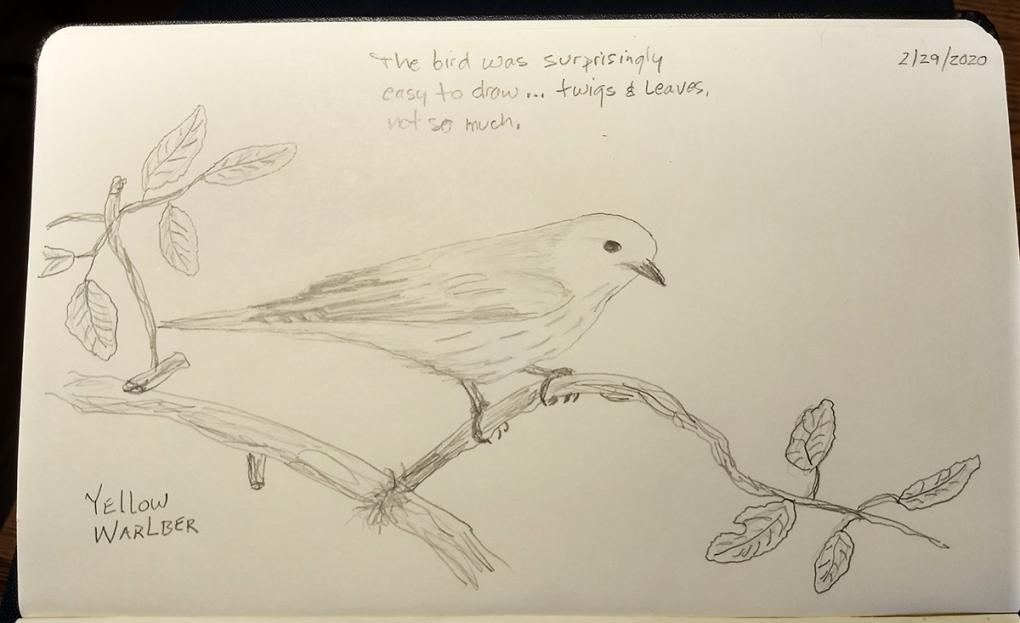
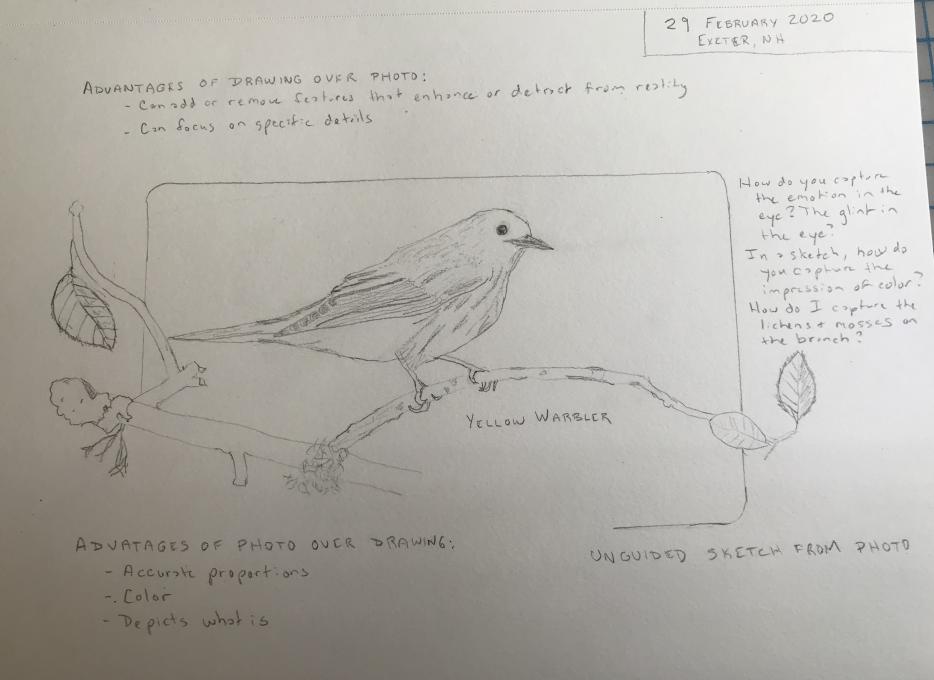
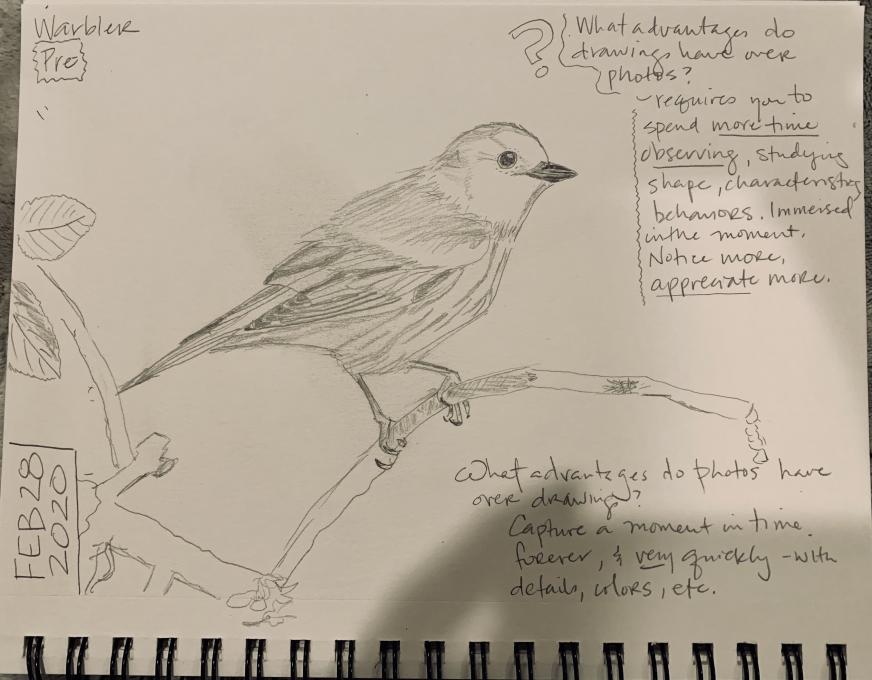
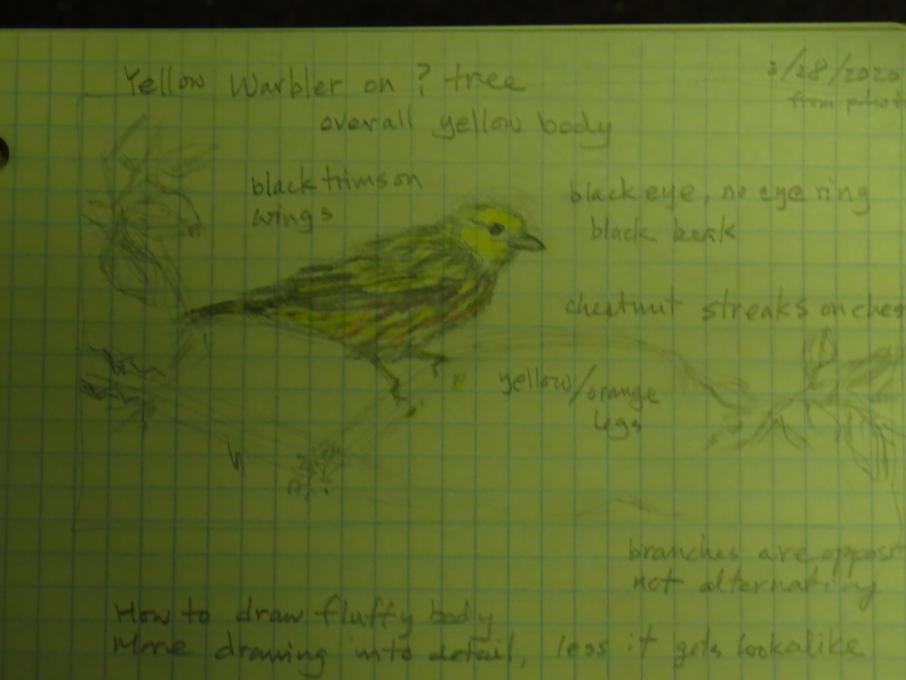 It helped me to look at details that I would not see by looking though a photo. It was difficult to draw feathers. I felt that more I tried to put details, further the drawing gets from the actual look. I am looking forward to learning painting different shades of colors.
It helped me to look at details that I would not see by looking though a photo. It was difficult to draw feathers. I felt that more I tried to put details, further the drawing gets from the actual look. I am looking forward to learning painting different shades of colors. 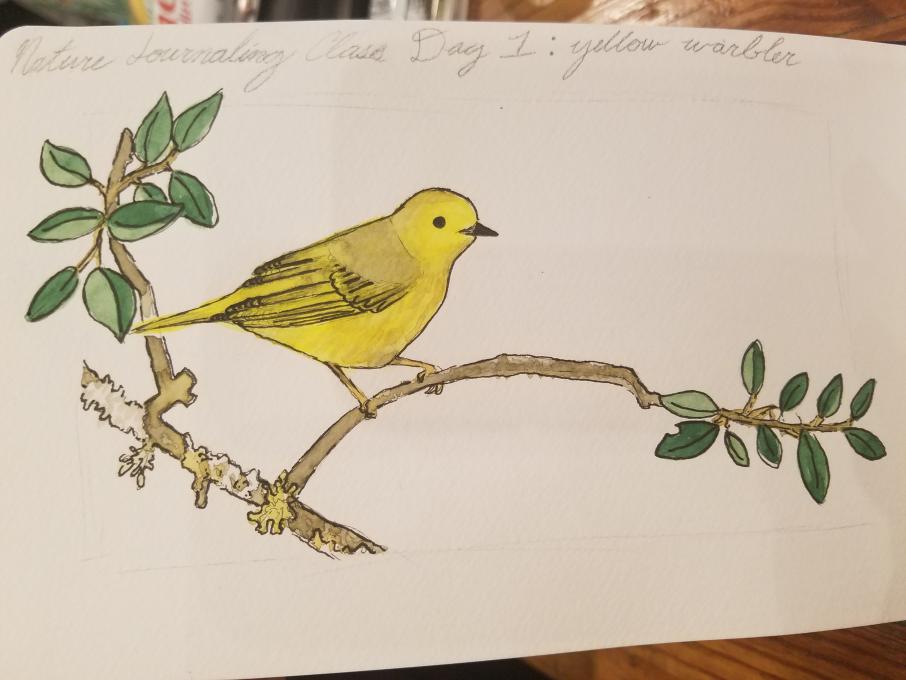 I really enjoyed drawing the leaves and branch but struggled with the bird. I couldn't get the depth in the feathers that I could see in the photo so I tried adding some outlines but I'm still not happy with how it turned out.
I'm excited to continue with the course to see how I can improve. I'm leaving the page blank next to this drawing so I can come back a re draw it right next to this one to directly compare the two.
I really enjoyed drawing the leaves and branch but struggled with the bird. I couldn't get the depth in the feathers that I could see in the photo so I tried adding some outlines but I'm still not happy with how it turned out.
I'm excited to continue with the course to see how I can improve. I'm leaving the page blank next to this drawing so I can come back a re draw it right next to this one to directly compare the two. 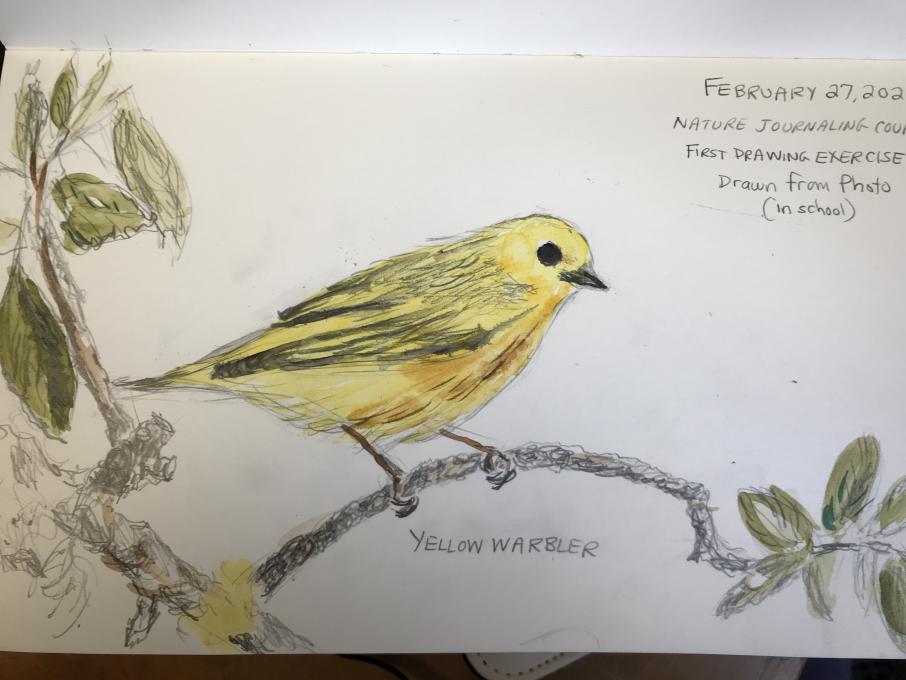
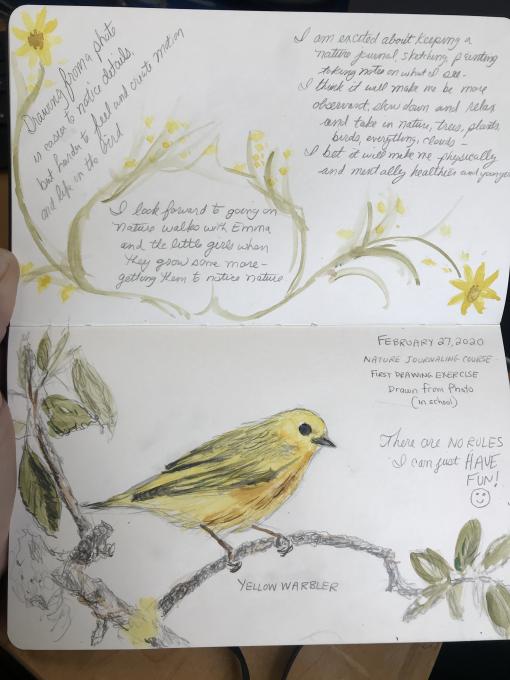
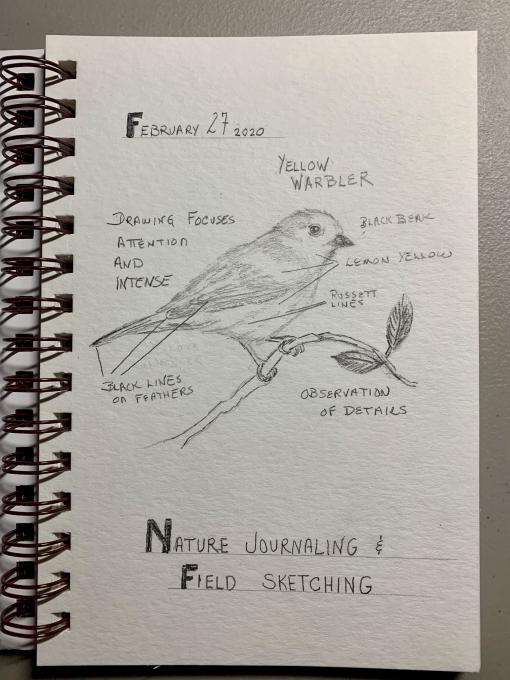
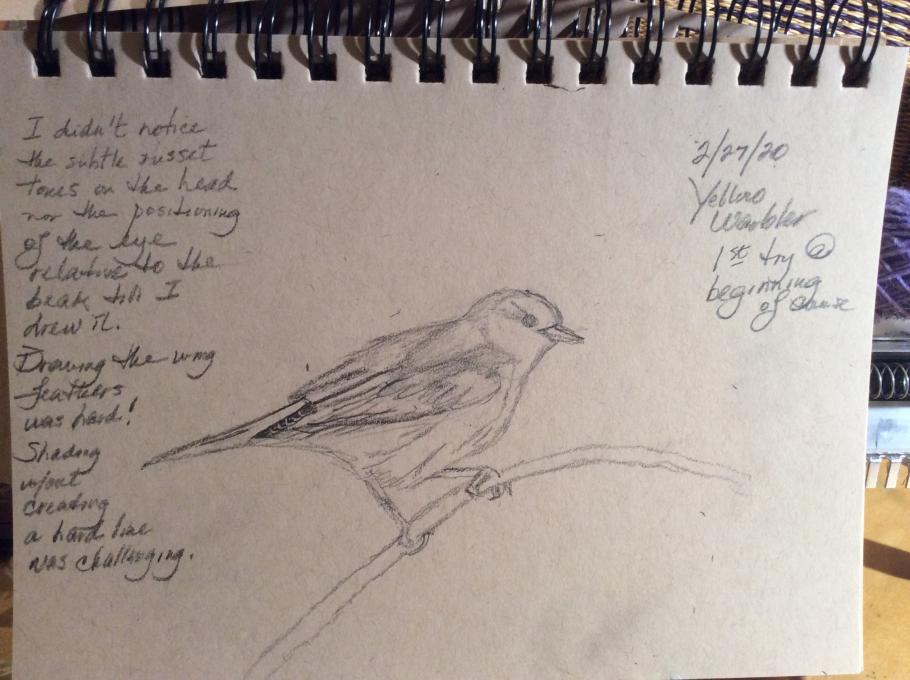
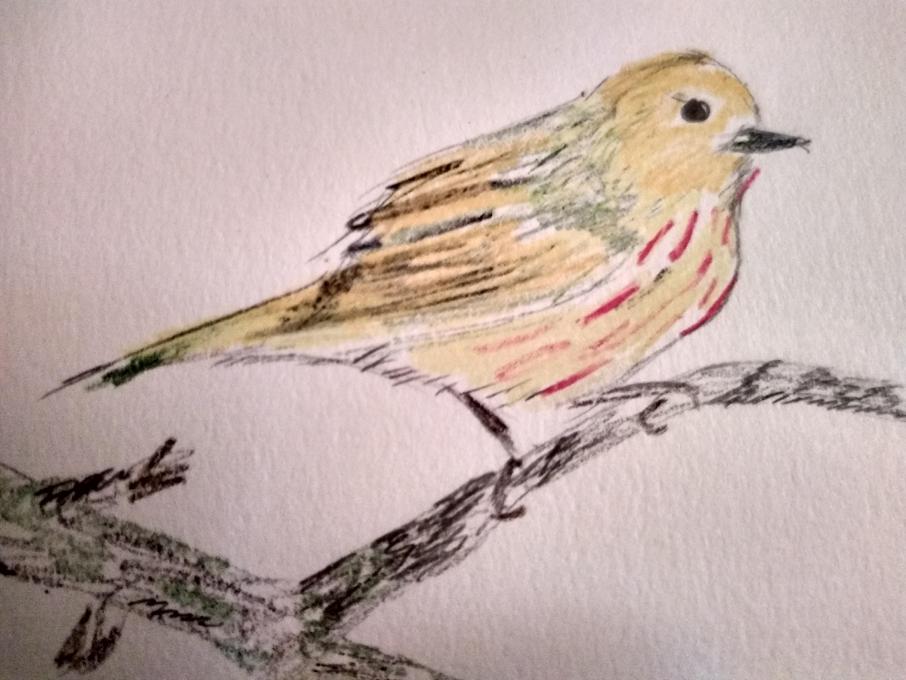 I just used my mechanical pencil then filled in with my kid's colored pencils. Didn't want to touch those watercolors yet, since I'm sure I would have made a mess. What I find impossible is how to make the "outline" disappear. Also, my drawing looks flat. I need to learn how to shade or whatever you call it to give the subject depth and curves and volume.
I just used my mechanical pencil then filled in with my kid's colored pencils. Didn't want to touch those watercolors yet, since I'm sure I would have made a mess. What I find impossible is how to make the "outline" disappear. Also, my drawing looks flat. I need to learn how to shade or whatever you call it to give the subject depth and curves and volume. 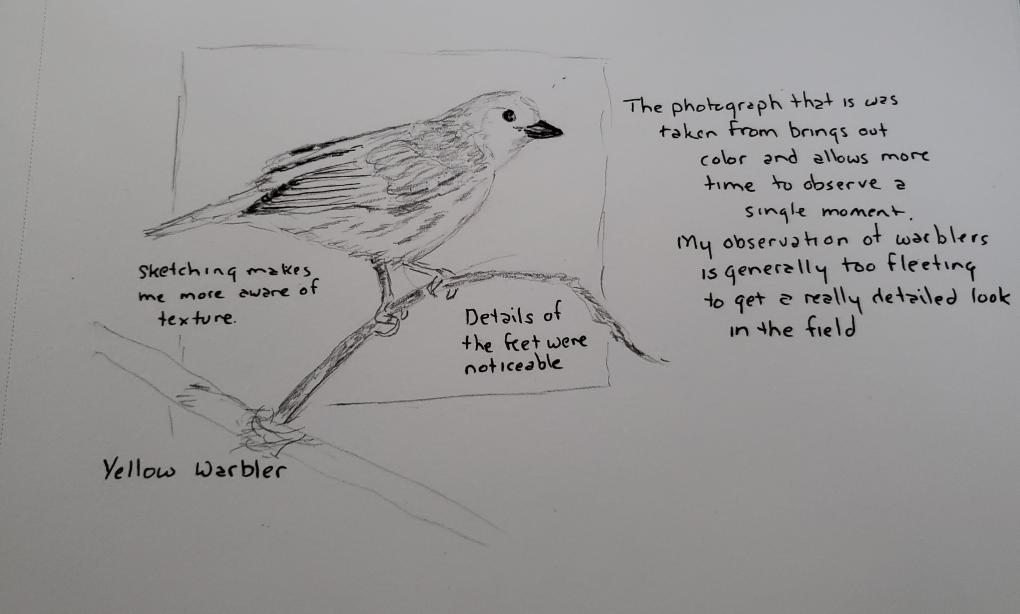
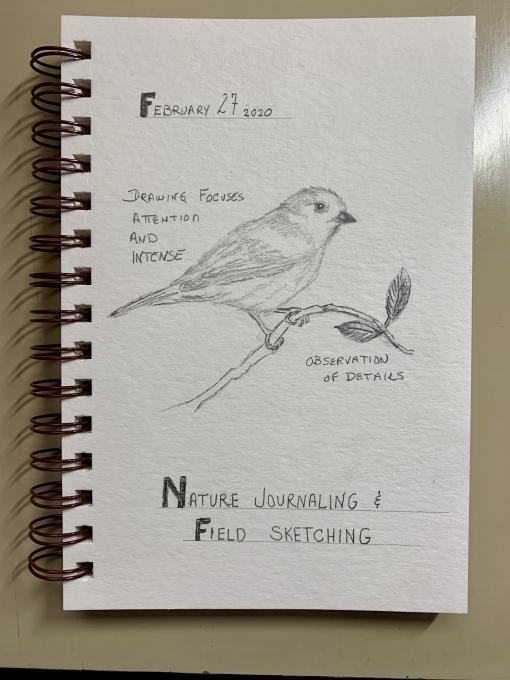
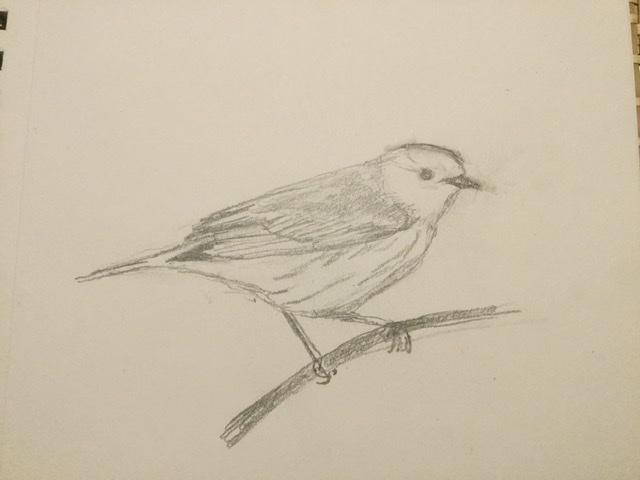
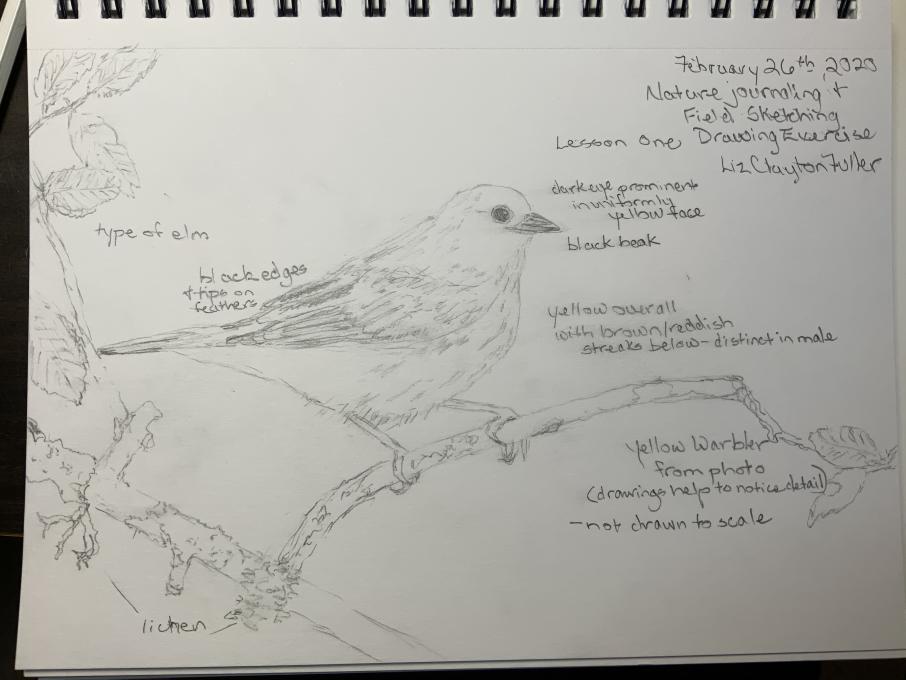 but have never drawn or painted from real life experience.
but have never drawn or painted from real life experience. 